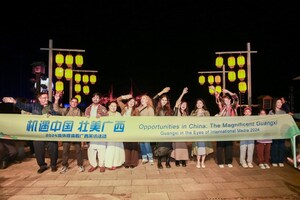China Daily: Chronicle of porcelain comes to life in Jingdezhen's museums
BEIJING, Oct. 17, 2023 /PRNewswire/ -- Museums serve as the best windows through which to view a city's culture and history, and in Jingdezhen, there are a variety of such assemblages that tell the story of this millennial porcelain capital.
Located in the northeast of Jiangxi province, Jingdezhen boasts a porcelain production history dating back more than 2,000 years, including over 10 centuries of kiln history and more than 600 years of imperial kiln history. One of its iconic landmarks is the Jingdezhen China Ceramics Museum, which features a circular kiln shape in its exterior design. Opened in 1955 as the first large-scale ceramic-themed museum in China, it tells the story of the city's porcelain journey through everything from loading and firing for production of the kiln furniture to crafting decorative artifacts.
One of the stars of the museum's collection is a blue and white vase featuring an intertwined pattern of peony branches. Dating back to the Yuan Dynasty (1271-1368), it was unearthed intact from an ancient excavation and is the only one of its kind in the world.
The Jingdezhen China Ceramics Museum holds more than 50,000 cultural relics and collections dating from the Neolithic Age to the Han (206 BC-AD 220) and Tang (618-907) dynasties. Starting in the Song Dynasty (960-1279), Chinese porcelain took a leading position among exported goods, and Jingdezhen porcelain spread throughout the world via the ancient Maritime Silk Road.
While the ceramics museum celebrates the long history of Chinese ceramics, the Imperial Kiln Museum sheds light on another of Jingdezhen's historic triumphs. Supported by the 600-year history of imperial kilns in the Ming and Qing dynasties (1368-1911), it showcases the city's archaeological achievements, including the remains of kiln sites from the Yuan to Ming and Qing dynasties.
Built in 2016, the Imperial Kiln Museum is designed in a shape that replicates Jingdezhen's traditional egg kiln and was constructed using kiln bricks. The museum displays ceramic fragments to illustrate the constant challenges faced by those working in the imperial kilns during the porcelain-firing process before ultimately succeeding in creating the perfectly fired blue-and-white porcelain.
The evolution of ceramics into an industry in modern China is the overriding theme of the Jingdezhen Industrial Heritage Museum. Built on the site of the Yuzhou Porcelain Factory's workshop for burning and smelting in Taoxichuan, a cultural and creative block is based on the Yuzhou factory established in 1958.
Two wooden walls respectively consisting of raft firewood for folk kilns and a wood-fired kiln for official kilns set at the entrance of the museum symbolize how ceramics underwent a mass revival in the early stages of the founding of the People's Republic of China. During this period, Jingdezhen opened 10 major factories in response to the industrial development of ceramics – including the Yuzhou factory. In response to the increased demand, the factories began industrialization production, which ensured the quantity and quality of their products.
In the 1990s, porcelain factories were phased out due to State-owned enterprise restructuring, but Jingdezhen's ceramics culture has been passed on. More diversified business patterns, including livestreaming and cultural and creative products that can be found in Taoxichuan and other districts are testimony to the great resilience of city's ceramics art.
SOURCE China Daily

WANT YOUR COMPANY'S NEWS FEATURED ON PRNEWSWIRE.COM?
Newsrooms &
Influencers
Digital Media
Outlets
Journalists
Opted In






Share this article